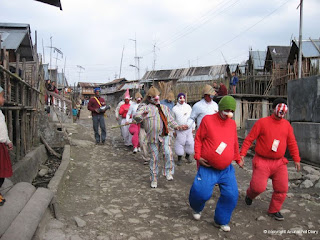Quite sometimes back, I came across a report which stated that penetration of Christianity in and around Lower Subansiri District was negligible (Joshua Project Report 2000). Then, at that time, I thought, with such an orthodox population that worships nature, would any religion make headway in the conversion process? But, I was wrong. Looking now, as in the case of Apatani plateau, conversion to Christianity has been rapid in these past few years and in case of Hinduism too, the conversion has also been going on, though not done overtly as Christianity.
This has made me think, isn’t it easy to manipulate and play around with simple, though at sometimes complex, highly orthodox Arunachalee peoples’ mindset and their outlook? I wonder, it is; and if it is on the line of their faith and belief, the easier it is. This was evident from the attendance it garnered during the recently concluded “Donyi Polo Day” (or rather Indigenous Faiths Day as was earlier known) observation on 31st last month at Donyi-Polo ground Hapoli.
What is Donyi-Polo and Donyi-Poloism?
Literally, Donyi means Sun and Polo means Moon. The descendants of mythical “Abotani”, which by and large follows animism, considers Donyi-Polo as one of their supreme powers among so many benevolent and malevolent supreme powers that governs their life. These supreme powers, in some way or the other, had some relation with the mythical Abotani as the folklore suggests. And since time immemorial, the descendants of Abotani had a ritual to erect altars of these supreme powers and make sacrifices in order to appease them, whenever these supreme or supernatural powers interfered with their lives. And this has been their religion.
But, in Indian perspective, animism is not recognized (I still remember the look on the face of interviewer when I said I don’t have any religion rather I’m an animist, in response to their question during my interview for a job – they were far from believing me, thinking either I was Buddhist or a Christian), and in order to have definite religious identity and to preserve the indigenous traditional faith, Donyi-Poloism was born and now it is recognized as a religion. And now, well, may be I guess I would say I follow Donyi-Poloism whenever I’m asked about my religion.
The Present Scenario
Going by what Donyi-Poloism stands for today, I may not say that I’m follower of Donyi-Poloism but would rather say that I’m an animist, if ever I’m asked about my religion. Why? Because it is totally devoid of the rituals that have been performed since time immemorial. Now, it has definite place of worship called “Medar Nello” or “Nyider Namlo” and has an idol too. So far, as I remember, the Apatanis or for that matter I presume even Adis or Nyishis (descendant of Abotani) had ever idol worshipped and in a designated place of worship called “Medar Nello” or “Nyider Namlo” as it is done today. Though as suggested above, only symbolic altars were erected whenever certain ceremonies or rituals had to be performed. Going by the way the rituals, that are performed now-a-days, in the so called place of worship vis-à-vis the rituals that are performed at temple, I wonder if it is akin to Hinduism or has influence of Hinduism. But then, with so many Hindu missionary leading the Medar Nallo, no wonder, if the rituals performed in the Medar Nello has Hinduism tone. And in some way or the other Donyi-Poloism has always been linked with Hinduism-Donyi with Surya Devta and Polo with Chandrama. But would someone tell those missionaries that Sun is feminine (Ayo Danyi) and Moon is masculine (Ato Piilo) unlike otherwise in Hinduism?
If Donyi-Poloism is akin to Hinduism, why people are thronging at Medar Nello?
As suggested in the previous para, the conversion to Christianity has been growing at a very rapid pace among Apatanis in these past few years and to put check on this conversion, Hindu missionary has simultaneously been trying to convert the population to Hinduism, albeit with little success. Those converted to Christianity, altogether not only stopped performing the earlier rituals but also started branding those practising the Traditional Rituals as the son of “Satan” as I’m told. This irked the highly orthodox Apatanis who performed the Traditional Rituals. And the Hindu Missionaries, which were working covertly on conversion, cleverly took advantage of this irked mindset by encouraging them to join Donyi-Poloism and to attend Medar Nello as it was their indigenous faith.
With their traditional ethos hurt and countering conversion of population to Christianity being the other motive, the people quite played into the hands of Hindu Missionaries and started attending the so called place of worship. After all, it had a Donyi-Polo tag, enough to let them believe that they are following their traditional form of faith and worship and not being almost converted to Hinduism.
Is Donyi-Poloism really an indigenous faith?
I would say no in the present context, but an altern
ate form of Hinduism. It has played into the hands of missionary and now has evolved into altogether different form of faith and practice with nothing indigenous about it.
Conclusion
With blatant rate of conversions- be it to Christianity or to Hinduism or to Donyi-Poloism (neo-Hinduism) and with the people who still orthodoxically follows the age old rituals and practice, I fear, in near future it may flare up communal tensions based on the religion and we would be witnessing riots due to the difference in opinions among them. Also, I fear, would we be able to retain our age old traditional custom, culture and faith for preservation of which, Donyi-Poloism was created?
What do you say?
 Hope they would address the issues of Ziro Hapoli in particular and entire Arunachal Pradesh as a whole.
Hope they would address the issues of Ziro Hapoli in particular and entire Arunachal Pradesh as a whole.


















